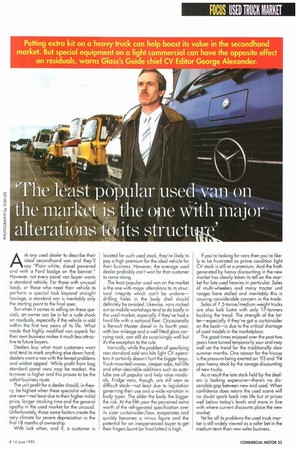'The least popular used van on the market is the one with major alterations tchits struct
Page 25

If you've noticed an error in this article please click here to report it so we can fix it.
Ask any used dealer to describe their ideal secondhand van and they'll say "Plain white, diesel powered and with a Ford badge on the bonnet." However, not every panel van buyer wants a standard vehicle. For those with unusual loads, or those who need their vehicle to perform a special task beyond straight haulage, a standard van is inevitably only the starting point to the final spec. But when it comes to selling on these specials, an owner can be in for a rude shock on residuals, especially if the vehicle is sold within the first two years of its life. What made that highly modified van superb for their own business makes it much less attractive to future buyers.
Dealers buy what most customers want and tend to mark anything else down hard; dealers want a van with the fewest problems and widest appeal. While profit from bog standard panel vans may be modest, the turnover is higher and this proves to be the safest business route.
The unit profit for a dealer should, in theory, be highest when these specialist vehicles are new—not least due to their higher initial price, longer stocking time and the general apathy in the used market for the unusual. Unfortunately, those same factors create the very climate for severe depreciation in the first 18 months of ownership. With luck when and if, a customer is located for such used stock, they're likely to pay a high premium for the ideal vehicle for their business. However, the average used dealer probably can't wait for that customer to come along.
The least popular used van on the market is the one with major alterations to its structural integrity which can't be undone— drilling holes in the body shell should definitely be avoided. Likewise, vans racked out as mobile workshops tend to do badly in the used market, especially if they've had a hard life with a national fleet. Occasionally a Renault Master diesel in its fourth year, with low mileage and a well fitted glass carrying rack, can still do surprisingly well but it's the exception to the rule.
Ironically, while the problem of specifying non-standard add-ons hits light CV operators it certainly doesn't hurt the bigger boys. Truck-mounted-cranes, sleeper cabs, tail-lifts and other desirable additions such as autolube are all popular and help raise residuals. Fridge vans, though, are still seen as difficult stock—not least due to legislation governing their use and a wide variation in body types. The older the body the bigger the risk. At the fifth year the perceived extra worth of the refrigerated specification over its sister curtainsider/box, evaporates and quickly becomes a minus figure and the potential for an inexperienced buyer to get their fingers burnt (or frost bitten) is high. if you're looking for vans then you're likely to be frustrated as prime condition light CV stock is still at a premium. And the Froth generated by heavy discounting in the new market has clearly taken its toll on the market for late used heavies in particular. Sales of multi-wheelers and many tractor unit ranges have stalled and inevitably this is causing considerable concern in the trade.
Sales of 7.5-tonne/medium weight trucks are also lack lustre with only 17-tanners bucking the trend. The strength of the latter—especially if they've got a curtainsider on the back—is due to the critical shortage of used models in the marketplace.
The good times enjoyed over the past two years have turned temporarily sour and may well set the trend for the traditionally slow summer months. One reason for the hiccup is the pressure being exerted on '93 and '94 year heavy stock by the savage discounting of new trucks.
As a result the late stock held by the dealers is looking expensive—there's no discernible gap between new and used. When confidence does return the used scene will no doubt spark back into life but at prices well below today's levels and more in line with where current discounts place the new market.
Yet for all its problems the used truck market is still widely viewed as a safer bet in the medium term than new sales business.






































































































